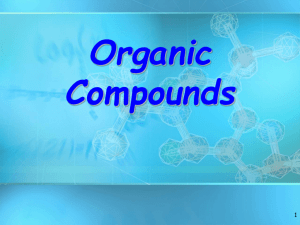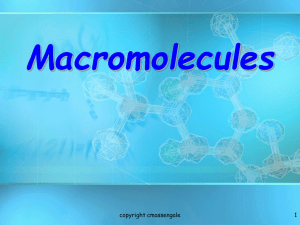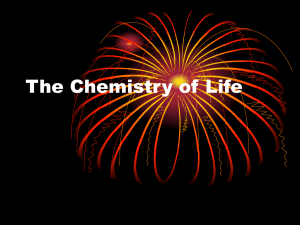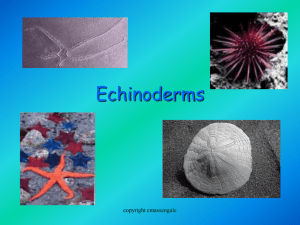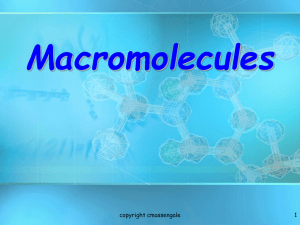Chapter 2 Macromocules
advertisement
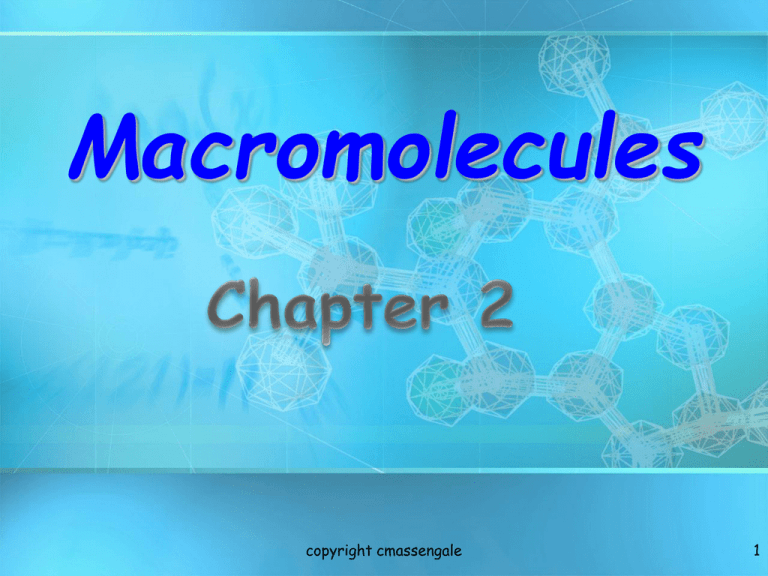
Macromolecules copyright cmassengale 1 Organic Compounds • Compounds that contain CARBON are called organic. • Macromolecules are large organic molecules. copyright cmassengale 2 Carbon (C) • Carbon has 4 electrons in outer shell. • Carbon can form covalent bonds with as many as 4 other atoms (elements). • Usually with C, H, O or N. • Example: CH4(methane) copyright cmassengale 3 Macromolecules • Large organic molecules. • Also called POLYMERS. • Made up of smaller “building blocks” called MONOMERS. • Examples: 1. Carbohydrates 2. Lipids 3. Proteins 4. Nucleiccopyright acids (DNA and RNA) cmassengale 4 Question: How Are Macromolecules Formed? copyright cmassengale 5 Answer: Dehydration Synthesis • Also called “condensation reaction” • Forms polymers by combining monomers by “removing water”. http://nhscience.lonestar.edu/biol/dehydrat/dehydrat.html HO H HO H H2O HO H copyright cmassengale 6 Question: How are Macromolecules separated or digested? copyright cmassengale 7 Answer: Hydrolysis • Separates monomers by “adding water” HO H H2O HO H copyright cmassengale HO H 8 Carbohydrates copyright cmassengale 9 WHY ARE CARBOHYDRATES IMPORTANT? They are the body’s preferred choice of energy . Just like your favorite shirt, you could wear the other shirt, but this one fits over your head without tugging. WHAT FOODS CONTAIN CARBOHYDRATES? Carbohydrates • Small sugar molecules to large sugar molecules. • Examples: A. monosaccharide B. disaccharide C. polysaccharide copyright cmassengale 11 Carbohydrates Monosaccharide: one sugar unit Examples: glucose glucose (C6H12O6) deoxyribose ribose Fructose Galactose copyright cmassengale 12 Carbohydrates Disaccharide: two sugar unit Examples: – Sucrose (glucose+fructose) – Lactose (glucose+galactose) – Maltose (glucose+glucose) glucose glucose copyright cmassengale 13 Carbohydrates Polysaccharide: many sugar units Examples: starch (bread, potatoes) glycogen (beef muscle) cellulose (lettuce, corn) glucose glucose glucose glucose cellulose glucose glucose glucose copyright cmassengale glucose 14 Lipids copyright cmassengale 15 Fats are triglycerides which are solid at room temperature. Oils are liquid at room temperature. Why are lipids important to our bodies? 1. Storage of energy. This way if you run low on carbs….. 2. Thermal insulation. 3. Mechanical protection. Example surrounding delicate organs such as the heart. 4. Waterproofing. Like the wax in your ears. Lipids • General term for compounds which are not soluble in water. • Lipids are soluble in hydrophobic solvents. • Remember: “stores the most energy” • Examples: 1. Fats 2. Phospholipids 3. Oils 4. Waxes 5. Steroid hormones 6. Triglycerides 17 Lipids Six functions of lipids: 1. Long term energy storage 2. Protection against heat loss (insulation) 3. Protection against physical shock 4. Protection against water loss 5. Chemical messengers (hormones) 6. Major component of membranes (phospholipids) copyright cmassengale 18 Some fats are called phospholipids. They look like this. Basically , the difference is that instead of 3 fatty The also have an end acids and one glycerol, they that loves to be in have 2 fatty acids and a water and a side that glycerol. repels water. Two layers together is a perfect way to surround a cell or a cell part! Also, by the way, some hormones are lipids. WHAT CAN YOU EAT TO MAKE SURE YOU HAVE LIPIDS? Butter Lipids Triglycerides: composed of 1 glycerol and 3 fatty acids. H O H-C----O C-CH2-CH2-CH2-CH2-CH2-CH2-CH2-CH2-CH2-CH3 O H-C----O C-CH2-CH2-CH2-CH2-CH2-CH2-CH2-CH2-CH2-CH3 O fatty acids H-C----O C-CH -CH -CH -CH 2 2 2 H glycerol copyright cmassengale 21 Fatty Acids There are two kinds of fatty acids you may see these on food labels: 1. Saturated fatty acids: no double bonds (bad) O saturated C-CH2-CH2-CH2-CH2-CH2-CH2-CH2-CH2-CH2-CH3 2. Unsaturated fatty acids: double bonds (good) O unsaturated C-CH2-CH2-CH2-CH copyright cmassengale 22 Proteins copyright cmassengale 23 WHICH FOODS PROVIDE PROTEINS IN OUR DIET? Proteins (Polypeptides) • Amino acids (20 different kinds of aa) bonded together by peptide bonds (polypeptides). • Six functions of proteins: 1. Storage: albumin (egg white) 2. Transport: hemoglobin 3. Regulatory: hormones 4. Movement: muscles 5. Structural: membranes, hair, nails 6. Enzymes: cellular reactions copyright cmassengale 25 Proteins (Polypeptides) Four levels of protein structure: A.Primary Structure B. Secondary Structure C. Tertiary Structure D.Quaternary Structure copyright cmassengale 26 Proteins also form some of the entrances and exits through the cell. Primary Structure Amino acids bonded together by peptide bonds (straight chains) Amino Acids (aa) aa1 aa2 aa3 aa4 aa5 aa6 Peptide Bonds copyright cmassengale 28 Secondary Structure • 3-dimensional folding arrangement of a primary structure into coils and pleats held together by hydrogen bonds. • Two examples: Alpha Helix Beta Pleated Sheet Hydrogen Bonds copyright cmassengale 29 Tertiary Structure • Secondary structures bent and folded into a more complex 3-D arrangement of linked polypeptides • Bonds: H-bonds, ionic, disulfide bridges (S-S) • Call a “subunit”. Alpha Helix Beta Pleated Sheet copyright cmassengale 30 Quaternary Structure • Composed of 2 or more “subunits” • Globular in shape • Form in Aqueous environments • Example: enzymes (hemoglobin) subunits copyright cmassengale 31 Nucleic Acids copyright cmassengale 32 Nucleic acids • Two types: a. Deoxyribonucleic acid (DNAdouble helix) b. Ribonucleic acid (RNA-single strand) • Nucleic acids are composed of long chains of nucleotides linked by dehydration synthesis. copyright cmassengale 33 Nucleic acids • Nucleotides include: phosphate group pentose sugar (5-carbon) nitrogenous bases: adenine (A) thymine (T) DNA only uracil (U) RNA only cytosine (C) guanine (G) copyright cmassengale 34 Nucleotide Phosphate Group O O=P-O O 5 CH2 O N C1 C4 Nitrogenous base (A, G, C, or T) Sugar (deoxyribose) C3copyright cmassengale C2 35 5 DNA double helix O 3 3 O P 5 O C G 1 P 5 3 2 4 4 2 3 1 P T 5 A P 3 O O P 5 O 3 copyright cmassengale 5 P 36 copyright cmassengale 37
